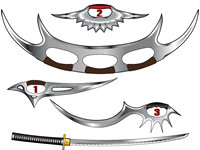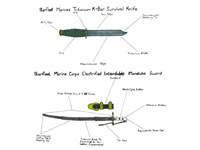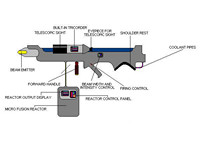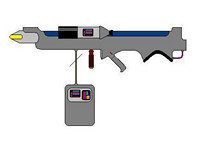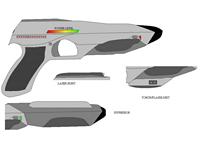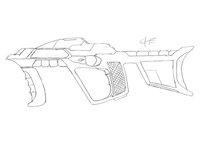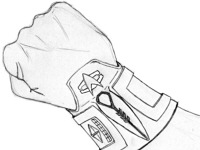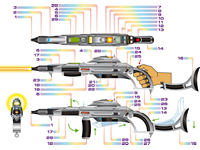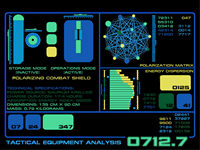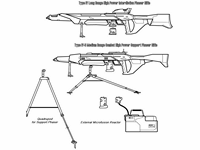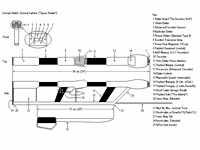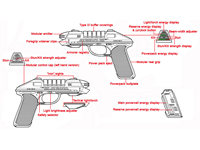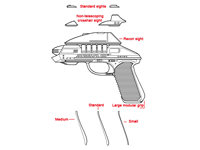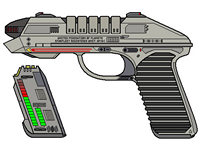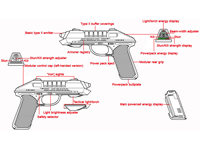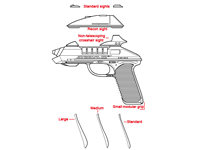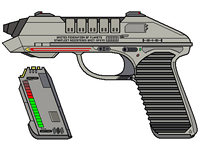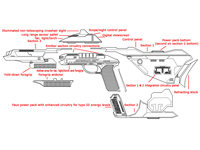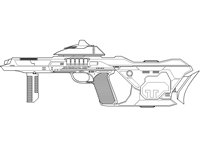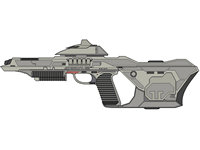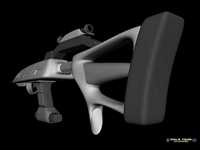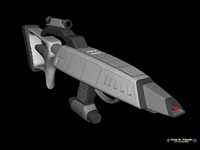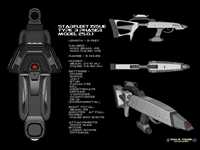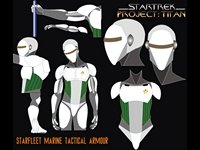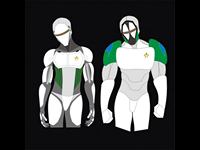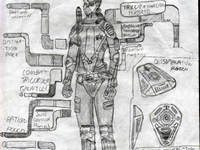Personal Weapons
Equipment, Personal Equipment, Personal Weapons
Alien Blade Weapons
Design by Gustavo Castillo
Three types of alien blades. The bat'leth and the katana on the illustration are for size reference only.
1. Tin lung tel (Dragon's wing)
Male Klingon warriors don't like this weapon. Even though it is a very effective, 65 cm long blade that can cut and slice in all directions, it lacks the momentum of a bat'leth or the rough unbalance of a mek'leth. Its name is not worthy of a warrior's attention either: "tin lung tel" means "Dragon's wing" (actually, the correct translation is "big lizard's wing", since there is no word for "dragon" in Klingonese) and the Klingons had already terminated all their dragons same time they killed their gods. May be the most important objection is, as they say, that it "cuts like a food knife, rather than a weapon" because, when attacking in a slashing motion with the blade, the cutting edge comes before the point, unlike a bat'leth, in which the points act first. For whatever reason, they consider it
"a woman's blade". Truth is that it is a 600 years old weapon created by Meruk, a noble warrior whose house fell into disgrace when he gave his support to a (later) defeated faction contrary to the ruling authority. Meruk's daughter, K'ianel, orphaned and dishonored, took the tin lung tel as the weapon of choice to restore her dignity. Using a pair of blades, one for each hand, she made quite a warrior's name during the battle of G'nerenth, saving the life of General Portek, who took her as his personal guard's head, at first, and his wife later. K'ianel developed the techniques and graceful movements for the tin lung tel that are still in use today. A skilled female wielder can successfully confront a male opponent armed with a bat'leth in an even match, because they are very light and fast, compensating for what they lack in potency. Lt. B'Enori, Chief Security Officer of the U.S.S. Arrogant is a celebrated tin lung tel master, with a large number of trophies to attest to that. She prefers them to a bat'leth, which she respects but considers a
"crude instrument".
2. O-nerep (the Tool)
The update of the Ushaan Tor, an Andorian ancient ice-mining tool turned into a traditional ritual weapon, the O-nerep (which's name literally means "the tool") is two hundred year old blade, shaped like a 58 cm wide metal fan with a handle at the rear. A very effective weapon when used in pairs, lethal at close proximity. It's the center of all Andorian armed martial arts. O-nerep artists, or "nerepke-imo" (ice tool holder), train in combat mostly against longer blades and spears to prepare for the worst possible odds. There are no appointed masters in its techniques, only instructors. When asked about the evolution of his/hers skills with "the tool", an expert would always say, humbly, "May be a decade after tomorrow I'll begin to understand the spirit of this instrument". That spirit is, according to tradition, the sum of the souls of every mining worker who lost his/her life at the job. In fact, the ritual war cry to start an O-nerep combat is "Me-Irem!" ("For Them!") The Andorian maximum sign of honor and respect is to receive the gift of an expert's own pair of O-nereps, specially if you are alien to their culture. After several years of working together, saving each other's life in countless occasions, Capt. Okode, of the U.S.S. Stubborn, was honored with his First Officer's, Commander Ekran, O-nereps, a gift that he cherish more than any of his numerous decorations.
3. Treth' enn (Scorpion's sting)
Enn is the name of an Orion's scorpion like (only bigger) desert creature, with a tail finished in a poisonous sting (tret). In ancient times, when confronted over the possession of a female "slave", Orion men took off the tails of these creatures (measuring about 40 cm long the tail alone) and engaged in mortal combat using them. With the development of blade weapons, this custom continued in a more "civilized" fashion: a short sword (77 cm overall length) resembling the shape of the enn's sting, soaked in their poison replaced the animal's tail. Of course first blood meant certain death. The frequent practice of such duels soon became a form of self defense and, later, a martial art. The poison soaking habit was dropped and a gentlemen's agreement replaced the killing part. It has been suggested that the women convinced their "masters" to stop killing each other, since the male population was dangerously decreasing in Orion. Fortunately, the martial art, called "guh' enn-et" or "holly scorpion's dance", grew strong and even the females practice it today as enthusiastically as the men. The name of the blade remains still: Treth' enn (scorpion's sting), the suffix h' meaning "belongs to". During a competition, out of respect to tradition, first contact with the opponent's blade means "sudden death" and defeat. When the slave traffic practice was outlawed in the Orion system and Orion became a full member of the United Federation of Planets, at the end of the 23rd century, Starfleet Academy opened its doors to Orions looking for a peaceful way to explore the galaxy, such as Lt. Tevos Medder, Chief Security Officer of the U.S.S. Stubborn, who is a Quilo, a dominant of the Treth' enn's art in all its aspects.
If you wanna see more come to my blogs: http://goodstavo2.blogspot.com/and http://goodstavo.blogspot.com/
Blade Weapons
Devised by Patrick Carroll AKA Bond, James Bond
Bladed weapons would seem to be something of an anachronism in late 24'th century combat but on the contrary field experience by the Starfleet Marines facing Jem'Hadar troops during the Dominion War and Klingon troops during the brief Klingon / Cardassian War showed that in the all too common environment of energy weapon dampening fields that gave rise to projectile weapons like the TR-116 Rifle Starfleet needed effective secondary weapons for close quarters combat against enemies that carried blade weapons themselves.
The Starfleet Marines K-Bar Survival Knife has been the traditional knife of the Marine Corps going back to when it was purely a US organization and has served with distinction since the early 20th century. The only modifications made by the Starfleet Marines include a more rugged tritanium blade that will not break or rust, and a laser cut monomolecular edge and stabbing point that will cut through almost any armor or material. These alterations do not make any cosmetic or weight / feel changes whatsoever and indeed a Marine from WW2 would notice little difference in his blade if he simply held it in his hand.
On June 3, 1804, Lt. Presley O'Bannon of the United States Marine Corps became the first Marine to carry the Mamaluke Sword when it was presented to him by Prince Hamet Karamanli in gratitude for restoring his rightly place on the throne at the signing of the peace treaty that ended the Barbary Wars. Marines have since carried the sword on the Dress Uniform as a sign of honor and loyalty, the very core of there motto "Semper Fidelis" (Always Faithful). It is still carried by Starfleet Marines to this day though it has been modified to serve as a combat weapon as well...
The current weapon is designed to retract it's tritanium blade from it's full length of 32 inches down to just 8 inches (length of the scabbard) so as not to disrupt the Marine while he is in motion. It has a laser cut monomolecular edge and tip to penetrate most armor types. When mounted inside the blade covering scabbard and turned on, the weapon can also act as an electrified stun baton for non-lethal riot control and prisoner submission engagements.
Man-Portable Phaser Cannon
Devised by Tyburn
Often jocularly referred to as the Phazooka, this is a shoulder-mounted type IV phaser cannon feeding from a separate powercell. It has a range of approximately 7000 metres, and the firing aperture can be set from a pencil-thin beam to one which covers the same area as two tennis courts at maximum range, although this particular setting can only be used with stun power, to incapacitate a crowd at long distance (perhaps providing support to law-enforcement personnel in crowd dispersion tactics).
Originally designed as a geological survey tool for creating boreholes, the more militaristic uses for this device became apparent after a group of geologists fended off an attack by Orion pirates using simply a pair of these. So the design was re-evaluated and became the MPPC.
Feeding from a micro-fusion reactor giving theoretically limitless firepower (within reason), the weapon can fire up to six one-second beams at full power in the space of a minute before the reactor capacitors are fully depleted and need to recover (which takes three minutes) The reactor is usually carried alongside the weapon, being set up in a firing position, though some canny operators fit straps to it for extra manoeuvrability and wear it as a backpack. The reactor has to be primed five minutes before use, hence some operators setting up before landing/beaming in order to be 'hot to trot' as the expression goes. A telescopic sight complete with tactical tricorder is fitted to the left side of the weapon, although with simple tools it can be switched to the right side for left-handed operators. The firing stud is still on the left side of the weapon though. To use: switch on the micro fusion reactor, ensuring clean boot-up of reactor control program. As the reactor comes up to power, use the tactical tricorder and telescopic sight to scan the target area and select beam width and intensity. When the reactor is fully charged, an indicator light will come on in the telescopic sight, and the operator may open fire. It is recommended that the operator checks the reactor output display at frequent intervals, particularly during sustained fire operations, to ensure that the reactor doesn't 'topple' (become unstable) In the event of this happening, it is a good idea to distance oneself from the reactor as soon as possible.
Meteor Phaser Pistol
Devised by Greg, description by USS Paladin
Work on the Starfleet Phaser Pistol Mark 10 began in early 2379, before the famed "Nemesis" incident. Starfleet desired a variable-yield pistol that was compact, lightweight, and suited for encounters with the Borg and a variety of hostile races. Added to this was the requirement of a degree of customization, allowing the pistol to accept silencers, laser sights, and flashlights, bringing its versatility in line with the Type-III phaser rifle's wide range of capabilities. The SPPM 10 also adopts the rifle's strictly weapon appearance, a stark contrast to the tool-like Type-II, a point of much debate during the design process. While originally intended to replace the Type-II in Starfleet Intelligence and other covert divisions, the SPPM 10 is steadily replacing the old Type-II phaser in the fleet itself.
The pistol, codenamed "Meteor" during the developmental phase, is an intriguing blend of old and new. For a more intimidating appearance and ergonomic feel, the partially Andorian team of designers referenced many projectile weapons of old, notably those of Earth. A molded hand grip provides comfort and accuracy, while the power pack nestled under the emitter can pop out easily to be recharged or replaced. The power level is changed simply by tapping the buttons on the back with one's thumb, and the weapon may be fired by squeezing the lightweight trigger. Power pack charge level and Weapon setting are displayed on the side, by way of small lights. The weapon is a mere 20 centimeters long, and can be carried easily in a belt-mounted holster.
Phaser Carbine
Devised by Chris Edmonds
The phaser carbine was devised for infantrymen that aren't riflemen such as anti-armor, medics, commanders, etc.
A "special fire control unit" feature can be nixed to make it a conventional lighter alternative to a fully-fledged phaser rifle. The handle is optional as well, and it can support a small two-round reloadable grenade launcher. The carbine comes with a primary power supply in the stock, and a secondary removable power supply in the grip.
There is also a PDW variant available, with the rear stock removed and replaced with a lighter folding stock. The large primary power cell is no longer present, relying completely on the smaller hot-swappable power cell. This variant is used mainly for armament on non-combatants such as technicians, or as emergency armament for pilots whose craft are downed.
Phaser Gauntlet
Devised by
Jeff Nielsen
Motivation
During the conflict with the Dominion/Cardassian/Breen Alliance many Starfleet personnel came into close quarters combat with the Jem'Hadar and Cardassian Military. Although the Starfleet personnel acquitted themselves bravely, the dedicated military personnel of the Cardassian/Dominion Alliance proved overpowering. The Jem'Hadar tactic of camouflaging themselves and engaging in close quarters combat demonstrated the need for a close quarters weapon for the Federation. With the Type 1 Phaser "Cricket" decommissioned, the Federation lacked a small, portable and concealable weapon for its personnel. The Starfleet Marine Corp placed a open call to known Federation weapons designers to solve the problem. Within 3 month several new small hand phasers had been submitted to the Marine Corp, however non proved to be any better then the retired Type 1. However, HiBeam Energies, the manufactured of the standard Type X (and better) ship phaser systems submitted a radical new design, the Phaser Gauntlet.
The Phaser Gauntlet incorporated the basic elements of the retired Type 1 Cricket hand phaser in a compact bracelet design. A beam deflection shield was placed onto the leading edge of the bracelet to prevent accidental damage to the operators hand. The beam itself is designed not to focus for the first 5 centimeters after firing. The refocusing of the beam 5 cm after leaving the prefire chamber prevents accidental close quarters damage. The Phaser Gauntlet was designed as a hands free weapon because of the hand to hand combat tactics of the Jem'Hadar, although the weapon has also proven effective against the Borg. The hand to hand combat methods of the Jem'Hadar often found Starfleet officers outmatched in sheer physical strength and agility. As well the first thing many hand to hand combatants will do is look to disarm their opponent. The engineers at HiBeam Energies decided that they would keep the hands completely free, and moved all the phasers components to a wrist/forearm gauntlet. This would allow the Officer the easy of movement the enjoyed from their hands, without the extra bulk and weight of a hand held weapon.
Various combat techniques were quickly developed by HiBeam Energies to utilize the Phaser Gauntlet. With the phaser being mounted in the gauntlet normal hand to hand combat could be achieved without sacrificing a weapon. Personnel would no long have to worry about having a weapon being knocked from their hands or dropped in combat. Their would be no 'delay time' wasted in drawing a weapon, simple point and shoot. Furthermore, in hand to hand combat the phaser could be fired at point blank ranges to inflict additional stun damage to explosive force. Although explosive force blows also required the use of a protective armored glove to provide additional protection from the resulting energies being released.
Technical Specification
HiBeam Energies Type 1G Phaser Gauntlet
Close Range Support Weapon
First Manufactured: July 25, 2371
Power Systems: Rechargeable and "Hot Swap" Sarium Krellide energy ampoule containing 1.3 x106 megajoules per centimeter. For a total power supply per ampoule of 6.4x106MJ.
Power settings: Capable of a full range of Phaser power setting from Level 1 through 10.
Level 01: Light Stun
Level 02: Medium Stun
Level 03: Heavy Stun
Level 04: Thermal Effect, low level burns and thermal blistering of humanoids and structures.
Level 05: Thermal Effect, deep level burns on humanoids. Personnel force fields penetrated after 5 seconds of contact.
Level 06: Disruption Effect, deep level burns and lacerations. Medium depth penetration.
Level 07: Disruption Effect, primary humanoids termination power setting. Immediate cessation of life functions.
Level 08: Disruption Effect, organic/humanoid tissues vaporize.
Level 09: Disruption Effect, light & medium alloys and ceramics suffer structural damage.
Level 10: Disruption Effect, heavy alloys suffer structural damage. Light
& medium alloys and ceramic suffer extensive damage.
Maximum range: 150 meters.
Effective range: 100 meters.
Safety systems: Along with the normal subspace transceiver array found in all Federation phasers, the Phaser Gauntlet also utilizes a combination nerve actuated firing unit and proximity detection chip implanted in the wrist of the Officer. The IFF Chip performs two distinct functions. The first is to allow the phaser to fire. A low level code is broadcast the subspace transceiver array that identifies the Officer as an authorized person to operate the Gauntlet. Without the broadcast ID the Phaser will not fire. The ID broadcast has a maximum effective range of 1.5 centimeters. The second function is to command the phaser to fire. The IFF Chip is injected with a hypospray into the nerve bundle at the base of the wrist. A combination of muscle contractions (and the corresponding nerve impulses) instruct the chip to command the Phaser to fire. To date there have been no accidental firings of the IFF Chip/Phaser Gauntlet.
Control interface: The surface of the Gauntlet contains two display indicators and one interface control. The upper unit displays the Phaser Gauntlet's current power setting via a bar indicator, the longer the bar the higher the damage setting. The second lower unit contains the beam width indicator. At it smallest the indicator appears as a single red LED in the middle of the bar. The wider the red LED appears the wider the beam width. The last set of controls is a pair of directional controls to increase or decrease the phaser power setting or beam with. Simple touch the appropriate display to control its intensity.
Phaser RifleMark VII
Design by Gustavo Castillo
1- Beam/pulse emitting crystal
2- Barrel
3- Shield emitter
4- Main sensor/light emitter
5- Front sight release
6- Front sight (passive)
7- Aimscope on/off switch
8- Power indicator
9- Rear sight (passive)
10- Aimscope viewing screen
11- Beam width control
13- Beam intensity control
13- Trigger
14- Grip
15- Aimscope
16- Removable buttstock
17- Prefire chamber
18- Collapsible auxiliary grip
19- Pulse charge level indicator (2 symmetrical)
20- Removable power pack
21- Power pack release button
22- Power pack level indicator
23- Sling swivel (2)
24- Rotating frequency on/off switch (2 symmetrical)
25- Pulse/beam mode selector (2 symmetrical)
26- Hand guard
27- Precision aiming trackball
28- Plasma acceleration chamber
29- Plasma compression chamber
Having always in mind the constant threat of the Borg and the disastrous recent experience with the Dominion and its Jem'Hadar troops, Starfleet Command decided to enhance the fire power of the foot soldier and the versatility of his/her weapons. "As it has been said a million times before, Starfleet is, mainly, a peaceful scientific exploration institution, but as the saying goes: 'Si vis pacem, para bellum', if you seek peace, prepare for war. We can't ever be sure of the intentions of our neighbors or the different lifeforms and cultures we'll encounter along the way. Sadly enough, we better be prepared for the worst", in the words of Admiral Kerensky, in charge of Tactical Weaponry Development.
The Phaser Rifle Type III, Mark VII is a lightweight yet powerful firearm that combines different shooting choices with a bigger, longer lasting power cell, and the familiar control simplicity and grip of a hand phaser.
Starting with the power cell: this is a pack of two separate components of opposite polarity, both consisting in two liquefied Murasaki gas mixing capable of generate 3 gigawatts of an electromagnetic energy stream each. This two streams are then joined into a plasma flux that suffers a violent acceleration first and is later compressed into a phased energy ray or pulse. This power cell allows a total of 90 pulse rounds at full power, or 30 shots at maximum dispersion angle (120°) and full intensity. The narrower the angle or the lesser the discharge the longer the duration of the power pack. At minimum stun setting is almost limitless. It is possible to use a detached power pack as an explosive device, forcing the uncontrolled intermix of the streams, causing an overcharge within the next 30 seconds. The resulting explosion is capable of destroying everything in a 25 meters radio, so is better to get away as soon as possible.
There is a colored light code built in each pack to show the charge level: green for fully charged, yellow means a half depleted pack and red when it's about to run out of juice. No light at all indicates no energy left in the pack. Replacing a exhausted pack is a rapid and easy task, performed in a single move via a clip-on mechanism with a release button at each side of the main body of the rifle.
Taking into consideration that not every species have the same finger configuration in their hands, the "pistol grip" was discarded in favor of the Type II, hand phaser style grip in which any person with an opposable thumb, or equivalent, can hold it and make it work properly (this covers almost every member of the Federation). On top of the grip there is the trigger and forward to it the beam width and intensity controls. Also forward to the grip, but at either side there are the pulse/beam mode selector button (silver) and the rotating frequency on/off switch (black). Below these we find the precision aiming trackball, which guides the aimscope for a precise target acquisition and multiple target selection. Every control is set in perfect symmetry, to accommodate left and right handed people as well.
At the lower rear of the grip there's a slot to attach a buttstock that helps keep the rifle steady when precision aiming is needed. Phasers don't work like old guns in which a powder explosion impulses the projectile forward, causing a backstroke, but when firing in pulse mode at full power, there is a slight backwards motion present, the stock prevents the lost of stability this may cause.
Ray width has 16 settings: 1 to 8 are for a rectilinear cylindrical beam and covers from 1 to 16 millimeters in diameter (with a dispersion rate of 0,002 mm every 100 meters). 9 to 16 are for angular dispersion, projecting a conical beam starting with a 5° angle, minimum setting, and ending in 120° for maximum area covering. When in pulse mode the phased burst is an energy sphere which sizes go from 10 to 50 milimeters in diameter, according to the setting.
Beam Intensity control also has 16 positions. The first five are for the stun mode, from mild stun (paralyzation without loss of consciousness) to complete incapacitation, the next six are perforation through solid matter levels, the last five settings are for disintegration, being the smaller (12th level) effective only on the first layer of the object and the last for complete molecular disruption level (total disintegration). These levels are true for pulse mode as well. According to the chosen force setting, an indicator in front of the acceleration chamber tells the user when the pulse reached full power and is ready to be fired. When the power cell is at full capacity this is instantaneous, but when the power pack's red light turns on having a visual confirmation is vital.
When width and intensity are both at maximum setting (120° dispersion and full disruption) the shot is only effective within a 7 meters radio and can only be sustained for 3 seconds.
The emitter , consistent in two pieces: one an aspherical amberoid crystal (ext) and the other a perfect sphere of dilithium (int), can also divide a single beam up to 6 times in different directions for multiple target acquisition. The targets are selected prior to the shot with the help of the aiming trackball and aimscope.
On top of the short barrel we find the shield emitter, that projects a level 3 deflector shield to protect the user from most kinds of weapons. It consumes a vast amount of energy, though, so it is advisable to turn it on only when strictly needed.
One of the most important innovations is in the rotating frequency control, that prevents Borg adaptation to Starfleet weapons. In addition to this, by means of a secondary ghost frequency generator, the beam carries not only its own signature but this false information as well, confusing the Borg sensors, allowing up to 10 effective shots, before the Borg adapt, where a maximum of 3 or, at best, 4 were possible. Both, frequency rotation and bogus emission, are activated at the same time with the same switch. This development was made possible by the information brought by the U.S.S. Voyager from the Delta quadrant.
The aimscope has the standard features as in previous models. When the last power cell is running thin there is the possibility of turning off the aimscope for power saving and release the front sight to aim visually (if light conditions are enough). This would mean to have power enough for one or two extra shots, which, in a desperate situation, could be all the difference between life and death.
Under the compression chamber there is a collapsible auxiliary grip to hold the rifle more steadily.
Please visit me at http://goodstavo.blogspot.com/and http://goodstavo2.blogspot.com/.
Polarizing Combat Shield
Design by M. Scott
Starfleet Mark V polarizing combat shield
Design base: Shiraav tactical research facility, orbiting Andoria
Production date: Stardate 8365; Terran year 2286 CE
Specifications for full shield: Mass- 0.79 kilograms. Dimensions- 20 cm diameter by 80 cm length, storage mode. 135 cm height by 80 cm width, operations mode. Material- flexible lightweight tritanium-aluminum alloy with an imbedded polarization matrix.
Power source: Hot swappable sarium-krellide power cell. Maximum charge duration: 17.4 hours. Absorption energy index: 65000 -- equivalent to direct attack by a Starfleet hand phaser on setting 10.
Basic premise and origin: The origins of the current Mark V polarizing combat shield can be found in 21st century Terran military technology, which employed primitive self-hardening materials during the last of the catastrophic World Wars; similar technologies had long existed among the Vulcans, Andorians and other species. This early technology was prohibitively expensive to create and maintain, and hence it was not until the mid 22nd century that polarized hull plating became practical on the scale of starship defense. This same technology, considerably refined, serves as the foundation of polarizing combat shields.
Motivation: The ground actions at the Battle of Donatu V in 2245 revealed a tremendous need for more potent personal defenses in combat situations; the existing tritanium body armor and hand shields, though effective against shrapnel or melee weapons, proved to be inadequate protection against direct fire by Klingon disruptors. Though small areas could be enclosed by forcefields or deflector screens, such technology was (and remains) too cumbersome to protect individuals in the field. Starfleet engineers quickly produced the Mark I polarizing combat shield, which was essentially an existing tritanium shield that had been refit with a small sarium-krellide power cell and a basic polarization matrix. This shield, like the polarizing field armor that accompanied it, was effective despite the added bulk and weight. Unfortunately, the original model could maintain full polarization for only 86 minutes without recharging, necessitating additional refinements.
Current design: The current Mark V model is a marvel of ergonomics, by comparison: while in storage mode, the shield can be carried as a slim, rolled cylinder. A DNA-coded switch on the carry-handle controls the polarization matrix. When activated, nanoservos cause the shield to extend to its full dimensions, and the sarium-krellide cell powers the polarization matrix. The result is an extremely durable and resistant shield that is capable of deflecting or absorbing all but the most powerful and direct weapons fire, without encumbering the personnel who employ it. Besides the full shield design, the same polarization matrix is currently employed in a smaller "buckler" model, which permits the use of both hands while using the shield, and a larger standing shield for superior coverage. Starfleet combat armor, and to a lesser extent, field uniforms, also make use of this technology to protect officers in hazardous situations.
Information sourced from: Star Trek: The Magazine's January 2002 article with André Bormanis, Memory Alpha's article on polarized hull plating, and Lee Kelly's Phasers.net. Concept from "Star Trek V: The Final Frontier".
Sniper Rifle
Devised by Nathan Fortner
Type IV Long Range High Power Interdiction Phaser
Maximum range: 500m-2km (varies with power setting)
Rate of fire: semi-automatic
Weight: 8kg (9 w/ power pack)
Power source: Standard Self Charging Power Cell
Power capacity before recharge: full power setting - 40 shot; stun setting - indefinite
The proposal for the Type IV Long Range Interdiction Phaser was brought before Starfleet Marine Operations Command in 2372 after the Targus IV Incident, when Starfleet Marines were unable to fend off a counterattack by a still-classified aggressor because of inferior weapons ranges. The enemy's formation tactics called for a new weapon that could accurately target and engage enemies from long ranges from a concealed position. As word of the ineffectiveness of the current Starfleet issue Type III phaser rifles spread, the Commandant of the Marine Corps pushed for Starfleet to adopt a new long range rifle, to be issued to a member of each fire squad and to two man sniper teams for covert actions. The Type IV was what came of that, and was adopted for field trials in mid 2373, with widespread use by late 2374. An interesting development on the Type IV is the integrated Light and Sound Suppression System. Through a classified method of quantum dampeners and sonic baffles, most of the light energy and sound produced by the phaser blast is absorbed in the suppressor without a noticeable loss of performance. Another feature is the Visual and Infrared Hybrid Sight System. By combining traditional light amplification systems and infrared, a true color digitally enhanced telescopic sight picture is provided to the shooter.
Type IV-B Medium Range Combat Support Phaser
Maximum range: 300m-1300m (varies with power setting)
Rate of fire: adjustable from semi-automatic to 800 pulses per minute
Weight: 10kg w/ bipod (tripod - 5kg, quadrupod - 8kg, microfusion reactor - 9kg)
Power source: self charging high capacity power cell -or- portable micro-fusion reactor
Power capacity before recharge: full power setting - 80 shot; stun setting - indefinite; reactor - indefinite on all settings
The Type IV-B Medium Range Combat Support Phaser (CSP) has recently come about to fill the need of a weapon that can lay down large amounts of fire accurately and effectively. The CSP fires pulses, much like a vastly underpowered pulse phaser cannon, instead of the traditional phaser beam. The CSP is light enough to be carried by one man, or a two man team if the reactor is being used. The CSP can be used as a heavy automatic weapon with the addition of a tripod. The tripod allows the weapon to be fired accurately at longer ranges at higher rates of fire from improvised or fixed defensive positions. The quadrupod acts on the same principle, although it extends to stand the height of the operator, to allow the operator to fire from a standing position, so as to be usable in a more diverse role, such as light anti-aircraft fire. The addition of an sensor enhanced sight system, which incorporates a tricorder feeding sensor data into the sight, makes the CSP much more effective at firing at moving targets from fixed defensive positions. The tricorder utilizes a specialized program that computes accurate lead data based on target distance, size, and speed, and sends that data into the sight, which corrects the sight picture, allowing the shooter to fire accurately at moving targets. The CSP can also be mounted coaxially or flexibly from vehicles, to be fired manually or, if fitted with actuators, remotely.
Starfleet Survival Carbine, Mark II
Devised by Win Mauk
Basics
The Survival Carbine is intended to be a relatively compact, easy to use and inexpensive to produce multifunction survival tool available for widespread use. It combines several well established technologies in new ways and it is designed to be adaptable, flexible, durable and moderately powerful. The device is variously known as: Space Heater, All-Purpose Tool, Spaceman's Best Friend, Fashion Accessory, Angle Iron, Away Team's Little Helper, Backup, Bindle Stick, Ax, Canned Heat, Portable Starship, Comfort Stick, Man Friday, et. al.
Motivation
The design of the Survival Carbine was primarily the brainchild of fourth year Starfleet Cadet Trimbal in 2375. His squad was given the academic assignment "Define what's wrong with the Federation and fix it." Part of their collective definition of what was wrong had to do with Federation worlds progressing at a lower level of technology feeling left out of the mainstream. It was noted that the expression "Second Federation" had gained currency among some of the representatives from such worlds.
The Mark I Survival Carbine, which did not include holographic or replicator technology, could be produced by almost any member of the Federation and provide them with income and, more importantly, self esteem. Many non-standard variations of the Mark I now exist, low quality imitations produced by non-Federation worlds, which are still formidable in their capabilities but which tend to malfunction with rough handling.
Worlds protected by the Prime Directive from interference in their normal technological development can still produce an almost complete Mark II ready for more advanced customers, or Starfleet itself, to install the replicator and holographic components.
The ability to produce a valuable "medium-tech" piece of equipment was intended to bridge the cultural gap that seems to exist between the Federation worlds that have the most advanced technologies and those that don't. This goal has to some extent been achieved even though the technological gap between these worlds continues to widen because the rate at which the "Have" worlds improve their technology is artificially increased by the introduction of newly discovered alien technology.
Along with the designs for the Mark I and Mark II, Trimbal's report encouraged the Federation to make every effort to assist starfaring races in the Federation in their advancement before destructive factionalism can develop. He added that this would also strengthen the Federation's economy and therefore it's ability to endure conflict. It is important to note that Trimbal is from a culture that has only recently achieved interplanetary travel (Sigma Iotia II), and therefore his motives may be questioned.
Since this was merely a Cadet's senior project it went largely unnoticed in Starfleet, however it did somehow come to the attention of several representatives to the Federation Council from so-called "Have Not" worlds. The Mark I has been in production on these worlds for several years and production is beginning elsewhere. Because the design included no technologies that weren't already available on these worlds there was no breach of regulations.
The Mark II has been used as standard equipment on many civilian vessels in Federation space and is gaining in popularity. It has been unofficially adopted by Starfleet Enlisted personnel throughout the Federation, who manufacture it for themselves as personal equipment in backwater areas where use of non-standard equipment is tolerated as long as the job gets done. It has also become a favorite possession of officers and crew alike in the Starfleet Corps of Engineers, who work in widely varying environments and appreciate the device's flexible utility. There have been several rumors about captains of starships, who were going on long exploration missions, manufacturing Mark II's in large quantities, stocking their vessel's escape pods and shuttles with them and then destroying them before coming within striking distance of any officers from the Inspector General's Office.
Even though the Mark II Survival Carbine is not standard issue in Starfleet it is included in this listing because it is now commonly found throughout Federation space and can frequently be found in the hands of Starfleet Personnel.
Description
The Mark II Survival Carbine is slightly smaller than a standard phaser rifle and, at 3.2 kg, weighs almost twice as much. It includes the following equipment:
(2 on the figure) two personal shield emitters, 120 degree arcs, 180 degree total coverage, allowing 60 degrees of overlapping, double coverage in the direction the Carbine is aimed.
(3) enhanced tricorder sensors, capable of supporting medical, geological, engineering, exobiology, and tactical tricorder operations.
(4) replicator emitter, capable of replicating small quantities of simple materials, such as, but not limited to, emergency rations, small containers of water, flint and steel, hand mirrors, loadstones, hook and line, and various other items stored in the Carbine's very limited memory.
(5) phaser emitter, standard for a Type II hand phaser.
(6) mid-range transceiver array, capable of sending and receiving boosted signals without overloading and directional signals to interplanetary ranges of up to 10 AU.
(7) power pack magazine, holding 10 commonly available power packs standard to the Type II hand phaser, and 2 spare power packs stored in the (17) fore grip.
(10) a standard tricorder with inputs for each of the Carbine's multiple functions hardwired in, and three extra inputs so that it should never be necessary to open the tricorder housing in the field.
(9) additional memory chips equivalent to 12 tricorders combined, only two thirds of this capacity is used by the Basic Survival Software Package.
(13) additional computational processors necessary for operation of the Micro EMH Program but which are available for alternate uses when the EMH is not on line.
(11) Holo emitter and voice interface, capable of projecting the image of the disembodied head of an EMH Mark I who will do his best to sooth and advise the injured while his invisible hands, as projected by the Shield Emitters, use whatever medical equipment is available to perform medical tasks.
Quote from Chief Michael "Smilin' Jack" Dugan, Drill Instructor, Starfleet Academy - "If you are wounded but can still manage to open the stock, drop the Medkit stored therein on the ground, prop the Carbine up on its pipod, lie down in front of it and say some words, like 'Activate E-M-H' or 'COMBAT MEDIC!' or 'I put the lime in the coconut and drank it all up,' or any other words you'd like to pre-program into the EMH activation sequence, it is highly likely that you will be patched up well enough to survive the experience.
(14) emitter controls, capable of reconfiguring any of the emitters housed in the (1) emitter array.
Chief Dugan - "It is possible to use the replicator to manufacture an emitter for a Romulan or Klingon style disruptor, a Milbrannan particle columnator, or a variety of other non-standard weapons. Any of these, properly configured, can be used to replace the replicator assembly in order to provide a more varied rotation of attack modes when trying to defeat Borg personal shields. Manufacturing such equipment is very costly in terms of energy. It will require about half your initial reserves, and then you won't get as many shots before your power packs run out. So don't try it unless you have a ready power supply that you can feed directly into your Carbine while you're making the new components, and hopefully recharging any power packs you may have already drained. And, after you remove the replicator emitter, DON'T LOSE IT! It may be the source of your next, and possibly last, meal.
(21) medkit and misc. survival tools; the tedkit is standard Starfleet issue but the miscellaneous survival tools vary greatly depending on the manufacturer. (Also, individuals restock their Carbines to suit individual needs. We've seen everything from toothbrush, floss and manicure set to garrot, throwing knife and loaded poison dispenser.)
(22) brushcutter, capable of cutting most exo-flora, very useful for a variety of needs in densely foliated territory, made of highly flexible, very hard composite ceramic alloy, non-conductive, never needs sharpening, also provides defense on worlds where the Prime Directive does not allow for use of advanced weapons. (It is, however, recommended that, under such circumstances, the tricorder be used to covertly record the items needed and manufacture them with the replicator so that local styles and materials can be held to.)
Results of Experiments and Simulations
Some simulations were performed by (then Senior Cadet) Trimbal on Academy holodecks. None of these were recorded and, from his verbal reports, we must assume that he simply "played" with the device, modifying it as he went, until he arrived at the design we now see, using the holodeck model as a template. It was never tested in the ordinary sense, but served so well in it's initial uses, and ever since, that no request for testing has ever been made. Therefore, there are no hard numbers regarding it's various capabilities or how those capabilities interact, positively or negatively. Some senior officers object strenuously to the Survival Carbine on the grounds that it presents capabilities that are far too aggressive for Starfleet's mission. It has been pointed out, by some, that none of these officers have found themselves in difficult circumstances with a Carbine close at hand. Starfleet Personnel who have done so uniformly give the Carbine high marks.
There is an unconfirmed report that Trimbal bypassed the safety protocols on a holodeck so that he could be wounded, with the brushcutter, to test the EMH program.
Conclusion
It is doubtful that Starfleet will be able to continue to overlook the value of this device for much longer. The many and varied uses to which it can be put are still being discovered by it's users, both in and out of the Star Service. A version of the Mark II, including all components except the brushcutter and phaser emitter, has been proposed. Discussions continue. Rumor suggests that Starfleet will eventually adopt a so-called "Type III" Survival Carbine which will have a better EMH feature and more computational ability but which does not include the Brushcutter and has less depth of power reserves. The rumor insists that this will provide an excuse to ban the Type II from use by Starfleet personnel.
Addendum
Chief Dugan - "If you need to use the brushcutter as a bayonet simply squeeze the fore grip to release the catch, and twist the fore grip for a brief moment. The brushcutter will extend halfway. It may be retracted by simply putting its tip against something hard, like a paving stone, and leaning on the Carbine until the blade is forced back inside the housing. Try it again, but twist the fore grip for a slightly longer time, and the blade will extend fully.
You may have noticed the unusual, horizontal placement of the blade. When the Carbine is held by the main grip and the mid grip you will have stability, leverage and control of the defensive equipment. Your blade will reach further than similar configurations found on Jem' Hadar weapons. With a lunge and an upswing an unprotected abdomen can be penetrated, the tip accessing vital internal organs in a path that proceeds diagonally upward. Should the abdomen elude you, you will find that the ribs of most humanoids are horizontal and that your blade will more easily slip between them in a horizontal position. This is certainly true of the Jem' Hadar. If, for whatever reason, you elect to strike at the head rather than the body you will find this stroke is ideal for penetrating the soft tissue under the chin of most humanoid species, again including the Jem' Hadar. And that is important, since this function was included in the Survival Carbine specifically to counter similar capabilities in their weapons.
Should you completely miss your target it is important to miss to the side which will allow you to rake the sharp edge of the blade on whatever body part your adversary presents to you as you step back and withdraw. For this reason I strongly recommend that you check your equipment as soon as you get it, to make sure the person before you wasn't a lefty, as it is much more advantageous to have the sharp edge of the blade facing the same side on which your primary hand holds the main grip. These motions are very simple and the Carbine is designed to be of use in these situations even for the most uncoordinated individuals, such as the group Starfleet has saddled me with today. You will note that performing these motions also places the housing of the Carbine so that its sensitive parts face your sensitive parts, and its tough parts will tend to protect these parts. Twisting the fore grip again will allow the blade and tang of the brushcutter to simply fall out of the housing of the Carbine when it's pointed downward.
The blade is heavy and sharp enough to cut about halfway through the booted foot of most Starfleet Personnel, so be careful where you let it drop. If you detach the padding from either the mid grip or the chinrest you will find that it can be used to provide a comfortable grip for the brushcutter. If you detach the trigger... I mean, main switch guard, which I know you will be employing for its proper function, and retrieve the heavy glove main switch guard from the medkit compartment you will be able to construct a knuckle guard. In this configuration the brushcutter is a deadly defensive deterrent, but, once again, it is the simplest of devices to use. Even a wet-behind-the-ears neophyte who is blinded by panic can raise the brushcutter up and bring it back down again in a series of frenetic and spasmodic down strokes that can be surprisingly effective even when used against a seasoned veteran who may be expecting a more tenative or well timed advance.
One of the great advantages of having the option of using such equipment is that is cannot be effected by energy dampening fields, it never runs out of juice and even if you do manage to some how break it half it will still function adequately. Further protections, such as basket hilts or a pummel can be produced by the replicator, but you must always use the replicator sparingly because the day may come when you would like to eat that pummel or drink that quillon. Having disassembled the brushcutter and returned all of its components to the housing of the Carbine we can now see its most notorious capability put into use. The mechanism that causes the blade of the brushcutter to extend from the housing of the Carbine is just that, a mechanism, a mechanical device powered by an old fashioned spring.
No amount of electronic counter measures will prevent it from working. And, if you carefully aim your Carbine at a target no more than about forty meters away you should have a reasonable chance of hitting that target when you twist the fore grip and hold it until the blade has left the housing. (Thwiiing... THUNCK!) Then the blade can be launched quite powerfully, so much so that it will usually pass right through most humanoid bodies. This concept was originally employed by human soldiers several hundred years ago in a nation-state called Switzerland, right here on Planet Earth, way back in the Twentieth Century. For them it was a knife, small enough to be tucked into a boot.
Obviously the power involved with the brushcutter's launching spring will allow much greater range, but the only way to use it accurately over such distances would be to combine the tricorder function with the enhanced processing to determine arcs of trajectory in several launchings and then combine that information with the holographically projected sights. Because of the inherently unstable flight characteristics of a projectile shaped like the brushcutter blade it would only work in relatively calm atmosphere, but it would have the advantage of traveling in an indirect path... and of course the tricorder could track it's target even through solid objects, like hills or rocks.
That concludes today's orientation regarding the non-energy using defensive capabilities of the Type II Survival Carbine. Dismissed."
TCP-SCN07 Type II Phaser Pistol
Design by Andrew K. L.
Settings: (16)
1. - Light stun
2. - Medium stun
3. - Heavy stun
4. - Low thermal effects
5. - High thermal effects
6. - Light disruption effects
7. - Moderate disruption effects
8. - Medium disruption effects
9. - High disruption effects
10. - Extreme disruption effects
11. - Slight explosive/disruption effects
12. - Light explosive/disruption effects
13. - Moderate explosive/disruption effects
14. - Medium explosive/disruption effects
15. - High explosive/disruption effects
16. - Extreme explosive/disruption effects
(source: http://www.phasers.net/)
Beam width settings: (5)
1. Standard
2. Moderate
3. Medium
4. Large
5. Full spread
Patent prototype model: GG-133UA
Year: 2371
Production line: Tactical Carbine Pistol (TCP)
Production model: SCN07
Year: 2376
Use: Restricted to be used exclusively by Federation/Starfleet marines.
Purpose:
- Adapt to any tactical operation ranging from starship close-quarter-battles (S-CQB) to full ground battlefield use.
- Combine with carbine field kit to create type III carbine.
Customizable features:
- Choices of rear grip sizes.
- Choices of sights ("iron sights", illuminated crosshair sights or spotter scopes).
- Forward underside (below emitter housing) hollow for attachment of tactical flashlights/torches or other devices.
Safety:
- Horizontal position lights red to indicate it is ready to fire.
- Angled position lights green to indicate the trigger is locked.
Powerpack: Full charge gives a maximum of 50 discharges set to maximum (16) setting and maximum beam width. Once drained, unlocking the reserve power cell gives a maximum of 4 discharges on the same settings. When reserve cell is unlocked, the main powercell will begin to recharge itself and require 16-20 hours. Interfaced with a recharge terminal and power supply the recharge time decreases to 2 hours. Drained reserve cell recharges itself within 8 hours. When set from light to moderate levels on stun settings as well as minimum beam width the main powercell will recharge quick enough to seem "unlimited."
TAP-SCN12 Type II Phaser Pistol
Design by Andrew K. L.
Settings: (16)
1. - Light stun
2. - Medium stun
3. - Heavy stun
4. - Low thermal effects
5. - High thermal effects
6. - Light disruption effects
7. - Moderate disruption effects
8. - Medium disruption effects
9. - High disruption effects
10. - Extreme disruption effects
11. - Slight explosive/disruption effects
12. - Light explosive/disruption effects
13. - Moderate explosive/disruption effects
14. - Medium explosive/disruption effects
15. - High explosive/disruption effects
16. - Extreme explosive/disruption effects
(source: http://www.phasers.net/)
Beam width settings: (5)
1. Standard
2. Moderate
3. Medium
4. Large
5. Full spread
Patent prototype model: GG-133UA
Year: 2371
Production line: Tactical Assignment Pistol (TAP)
Production model: SCN12
Year: 2374
Use: Restricted to be used exclusively by Federation/Starfleet personnel.
Purpose: Adapt to any tactical operation ranging from general security duty to starship close-quarter-battles (S-CQB).
Customizable features:
- Choices of rear grip sizes.
- Choices of sights ("iron sights" or illuminated crosshair sights).
- Forward underside (below emitter housing) hollow for attachment of tactical flashlights/torches or other devices.
Safety:
- Angled position lights red to indicate it is ready to fire.
- Horizontal position lights green to indicate the trigger is locked.
Powerpack: Full charge gives a maximum of 50 discharges set to maximum (16) setting and maximum beam width. The main powercell will begin to recharge itself and require 16-20 hours, interfaced with a recharge terminal and power supply the recharge time decreases to 2 hours. When set from light to moderate levels on stun settings as well as minimum beam width the main powercell will recharge quick enough to seem "unlimited."
TCP-SCN07 Type III Phaser Carbine
Design by Andrew K. L.
Settings: (20)
1. - Light stun
2. - Medium stun
3. - Heavy stun
4. - Low thermal effects
5. - High thermal effects
6. - Light disruption effects
7. - Moderate disruption effects
8. - Medium disruption effects
9. - High disruption effects
10. - Extreme disruption effects
11. - Slight explosive/disruption effects
12. - Light explosive/disruption effects
13. - Moderate explosive/disruption effects
14. - Medium explosive/disruption effects
15. - High explosive/disruption effects
16. - Extreme explosive/disruption effects
(source: http://www.phasers.net/)
Carbine-exclusive settings:
17. - Pulse discharge on stun settings
18. - Pulse discharge on kill settings
19. - Sniper pulse discharge (maximum range: 1650 meters - deplates 1/4 of a powerpack, shot accuracy is moderate)
20. - Sniper beam discharge (maxmium range: 830 meters - depletes 1/2 of a powerpack, accuracy is practically pin-point)
Beam width settings: (5)
1. Standard
2. Moderate
3. Medium
4. Large
5. Full spread
Patent prototype model: GG-133UA
Year: 2371
Production line: Tactical Carbine Pistol (TCP)
Production model: SCN07
Year: 2376
Use: Restricted to be used exclusively by Federation/Starfleet marines.
Purpose: Adapt to any tactical operation ranging from starship close-quarter-battles (S-CQB) to full battlefield use.
Customizable features:
-Choices of rear grip sizes.
-Choices of sights from illuminated crosshairs to tactical operation scopes.
-Standard scope has integrated illuminated crosshair, tactical flashlight/torch as well as enhanced digital display.
-Telescoping/retracting stock.
Safety:
-Horizontal position lights red to indicate it is ready to fire.
-Angled position lights green to indicate the trigger is locked.
Powerpacks: Full charge gives a maximum of 95 discharges set to maximum (16) setting and maximum beam width. Once drained, unlocking the reserve power cells gives a maximum of 12 discharges on the same settings. When reserve cells are unlocked, the main powercells will begin to recharge themselves and require 24-30 combined hours. Interfaced with a recharge terminal and power supply the recharge time decreases to 3 1/2 combined hours. Drained reserve cells recharge themselves within 12 combined hours. When set from light stun settings up to moderate kill settings with minimum to medium beam width the main powercells will recharge quick enough to seem "unlimited" (depending on the wait period in between discharges and condition on each powerpack).
Type-3 Phaser Model 25.0.1
Devised by James Trexler
Type-3 Phaser with a 1.05 caliber pulse and a .45 caliber beam. Accurate to a range of five miles. Settings include phase, shock, jolt, stun, paralyze, kill, disintegrate, defrag, vaporize, quantumize, and the experimental De-M setting. Capable of 45 minutes of full beam power or 200 shots. Includes a 1000x magnification scope and a laser scope.
The Type-3 Phaser Model 25.0.1 was commissioned as a phaser rifle which would replace all different models of phaser rifles which were in use at the time. It was designed to be light weight for extra vehicular activity, durable for intense close quarters combat, and includes an external power pack for easy recharging. The Model 25.0.1 is also the first phaser to be equipped with the experimental De-M setting. This setting involves disassociating all fundamental strings within the target from the universe's membrane. This results in the target being completely dissolved with no remaining fundamental particles or energy to leave traces. The setting, however, is not entirely stable and often causes the phaser to disintegrate in the user's hands and the power pack exploding. The phaser was first used to equip the USS Avenger NX-101468 and proved its usefulness during the Parallel Universe War of 2403.
Courtesy of AC3D 3d modeling software
Various Ground Troop Equipment
This is a collection of ideas how Starfleet ground troops could be equipped, considering that the standard issue uniform is hardly suited to sustain a longer combat or peace-keeping mission.
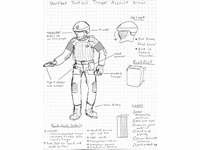
Tactical suit by
Lance, ASDB Member

